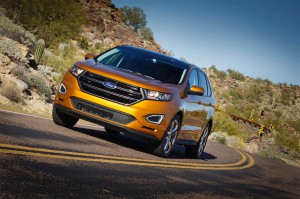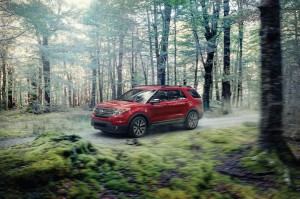
The 2015 Ford Edge is enjoying a sales boost as part of the low gas prices, but Ford expects the trend to continue for some time.
While trucks and utility vehicles are thriving in this era of low gas prices, Ford Motor Co. expects passenger cars to account for a smaller share of global sales over the next five years.
By 2020, passenger cars will account for 43% of Ford’s global sales, compared to 49% in 2014. Utility vehicles will grow from 24% of the company’s total sales to 29%, while trucks grow from by one percentage point and account for 28% of Ford’s total sales.
Michele Bartlett, a Ford marketing expert with experience selling both utility vehicles and passenger cars, said customers not only the United States, but also in Europe and other parts of the world have come to appreciate the packaging and versatility found in the utility vehicles of all sizes.
The broad appeal of utility vehicles, which attract a broad cross-section of buyers, is helping fuel the growth of utility vehicles sales – and competition – worldwide, she added. “Utility vehicles are big in China,” she noted.
Moody’s senior analyst Charlie O’Shea said the strength of light trucks and utility vehicle sales has helped lift the auto industry’s sales in recent months “Light trucks, including SUV’s, are very popular,” he said, rising almost 12% in February.
Ford isn’t the only manufacturer benefiting from the strong sales of the utility vehicles.
Fiat Chrysler Automobiles chief executive Sergio Marchionne earned a salary of $7.2 million in 2014, but was also awarded a one-time bonus of approximately $24.6 million for his strategic contributions to the company, which included boosting sales of the Jeep brand past 1 million units for the first time in history Jeep sales are up almost 20% again in the first two months of 2015.
The popularity of truck and utility vehicles is also helping other companies. Lexus has climbed back into contention in the race for the luxury sales crown in the U.S. thanks to the strength of the new Lexus and Acura sales lean heavily on the Acura MDX.
“With gas prices likely to remain low, (the truck) segment is likely to continue to grow for some time,” said Jeff Conrad, general manager of the Honda brand, during a media drive of the new HR-V last week. “The challenge, he acknowledged, will be to “get our fair share.”
(First production Fisker Rocket Mustang ready for delivery. For more, Click Here.)
New for 2016, the Honda Pilot gets a dramatic exterior restyling with its customary boxy shape replaced with sculpted curves.
Trucks, which had been losing share to cars during the Great Recession, as fuel prices soared to record levels, have more than recovered. They now account for 54% of the overall U.S. market, up from 51.4% a year ago, according to sales tracking firm Autodata.
(Click Here for details about the next-gen Camaro.)
IHS Automotive anticipates sales of all utility vehicles will grow to 5.86 million this year, up from 5.5 million in 2014. By comparison, the firm forecasts sedan sales will be flat, at around 5.8 million.
Ford, meanwhile, is updating the Ford Edge and Ford Explorer to retain its strong presence in the utility market. The Edge, Explorer and Escape are all leaders n the respective utility vehicle segment, Bartlett noted.
(To see more about how well the Mustang is doing overseas, Click Here.)
Christina Aquino, marketing manager for the Ford Edge, also noted the customers for Edge tend relatively affluent, urban professionals with incomes of more than $100,000. Utility vehicles also attract more women buyers, she said.


Yep, called this one 3-4 years ago. The “Big 3” will be the large truck and SUV producers. The transportation cars, commonly known as “P.O.S.” will all be made by import companies. There won’t be much distinction in design and the color silver. The F-150, Super Duty and the Expedition will be the main horses in the Ford stable. GM’s Surbruban/Tahoe , large trucks and the smaller Colorado’s will be their bread and butter. Chrysler has Ram and Jeep to carry them. The 3 muscle cars will have a niche market.
The Big Three are capable of producing good cars but SUVs and pick-ups are the financial gravy train for them.
The Euro car makers who produce excellent cars and few or no pick-up trucks. They will continue to do fine as they add more SUVs to their U.S. offerings.
I understand that U.S consumers have an SUV mentality even when they don’t need an SUV or pick-up truck. Some of us actually know how to drive and prefer to drive a well engineered Euro car. Even though the Asian cars have improved over the years, I have yet to find one that I’d pay for or want to drive daily.